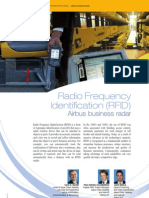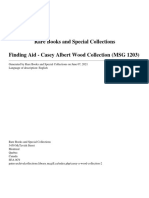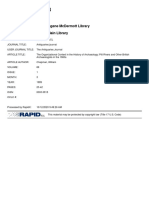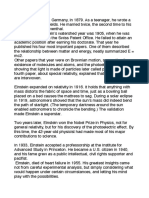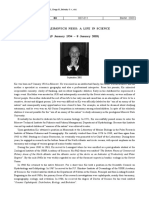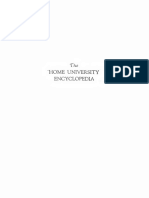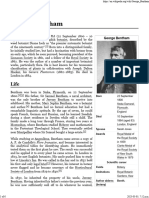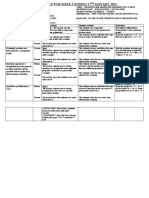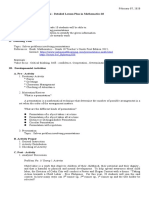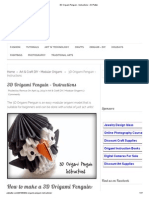Henry Woodward Padre
Henry Woodward Padre
Uploaded by
Barrabax LaksCopyright:
Available Formats
Henry Woodward Padre
Henry Woodward Padre
Uploaded by
Barrabax LaksCopyright
Available Formats
Share this document
Did you find this document useful?
Is this content inappropriate?
Copyright:
Available Formats
Henry Woodward Padre
Henry Woodward Padre
Uploaded by
Barrabax LaksCopyright:
Available Formats
THE
GEOLOGICAL MAGAZINE
VOLUME UVIII.
No. XI.NOVEMBER, 1921.
OBITUARY. Henry Woodward.
BORN 24TH NOVEMBER, 1832. DIKD 6TH SEPTEMBER, 1921.
HENRY WOODWARD
was born at Norwich on 24th November, 1832, the youngest, son of Samuel Woodward, the well-known geologist and antiquary. His father died when he was 6 years oldj and his early life was spent under difficult circumstances. He was educated at the Norwich Grammar School until the age of 14, when he left to accompany his brother, Samuel Pickworth Woodward, to Cirencester. where the latter was beginning his career as Professor of Natural History in the Royal Agricultural College. Henry Woodward was by inclination a naturalist from the beginning, and at Cirencester he had the opportunity of making systematic studies. In 1848 he removed to London with his brother, who was then appointed assistant in the Geological Department of the British Museum. Here he attempted to obtain congenial occupation, which would at the same time maintain him, but in 1851 he felt obliged to return to Norwich, where he spent seven years as a clerk in Gurney's Bank. At last, in 1858, he realized his ambition, and became an assistant in the Geological Department of the British Museum, of which he was eventually Keeper from 1880 until 1901. As an officer of the British Museum, Henry Woodward devoted himself most assiduously to curatorial work, and when the collection of fossils was removed to South Kensington at the beginning of his Keepership, he planned and supervised the whole of the rearrangement in the new building. He made the public galleries more attractive by adding illustrative diagrams and descriptive labels, and he improved the guide-books by providing them with figures of important specimens. He also increased the value of the collections for the progress of science by planning and editing a series of catalogues, among which may be specially mentioned Etheridge and Carpenter's Blastoidea, Hinde's Fossil Sponges, Smith Woodward's Fossil Fishes, and Lydekker's Fossil Reptiles, Birds, and Mammals. His genial personality and helpful ways attracted an increasing number of scientific visitors, and as a result of his efforts the extent and scope of the collections enlarged with greater rapidity than at any previous time. He acquired not only
VOL. LVIII.NO. xi. 31
http://journals.cambridge.org
Downloaded: 20 Nov 2010
IP address: 8
482
ObituaryHenry
Woodward.
an immense mass of material for research, but also numerous particularly fine specimens which would be instructive for the public exhibition. Among the more important acquisitions were Williamson's Carboniferous Plants, Davidson's Brachiopods, Nicholson's Stromatoporoids, Stiirtz's Devonian Starfishes, Egerton and Enniskillen's Fishes, Lewis' Lebanon Fishes. Leeds' Oxfordian Reptiles, and Forsyth Major's Pliocene Mammals from Samos. In 1864 Henry Woodward joined Professor T. Rupert Jones in founding the GEOLOGICAL MAGAZINE, and from July, 1865, until the end of 1918 he was sole editor. It is unnecessary to refer to the influence of this serial on the progress of researchit is sufficient to repeat the common saying that almost every British recruit to geology since 1864 has begun authorship in its pages. Under Woodward's judicious and tactful editorial direction, it always welcomed and published honest work, wThether on orthodox lines or otherwise ; and it afforded a medium for discussion not to be found elsewhere. If his well-laid plans and methods are followed, the MAGAZINE cannot fail to continue its usefulnessprovided, of course, that the new generation is willing to give it the same financial support .as its predecessors. Soon after he joined the staff of the British Museum, Henry Woodward began to write notes on newly acquired fossils, which were of general interest. Among these his account of the primitive Jurassic bird, Archaeopteryx, in the Intellectual Observer for 1862, must be specially mentioned. After the foundation of the GEOLOGICAL MAGAZINE, most of his notes were contributed to its pages, and one of these, in the first volume, on the skull of a mammoth found at Ilford. is particularly memorable. In this communication the first well-preserved skull of an English mammoth is noticed, and as soon as the specimen was mounted in 1868 he pointed out the true inward curvature of the tusks, which showed that in the published figures of the Siberian mammoth in Petrograd the tusks were reversed. In 1869 he wrote on the peaty deposits in the Lea valley, in which numerous Holocene mammalian remains had just been found. In this, and in a later paper, published by the Essex Field Club in 1882, he emphasized the geological importance of the wrork of beavers, both in the Lea valley and in the Fenland. In 1874, in a paper read before the Geological Society, he discussed the fossil links between birds and reptiles, and referred to the footprints of bipedal reptiles in the lithographic stone of Solenhofen, Bavaria, fn 1885, to the same Society, he gave an account of a skeleton of the gigantic extinct Sirenian, Rhytina, which had recently been acquired by the British Museum. Henry Woodward's chief contributions to science, however, were his descriptive memoirs and papers on fossil Crustacea and other Arthropods, on which he became a leading authority. The first of his long series of original papers, on a new macrurous Crustacean from the Lower Lias of Lyme Regis, was published by the Geological
http://journals.cambridge.org
Downloaded: 20 Nov 2010
IP address: 8
ObituaryHenry Woodward.
483
Society in 1863. From 1865 to 1875 he contributed an annual report on British fossil Crustacea to the British Association, and made many advances in knowledge of the subject. In 1864 he exhibited to the British Association at Bath some restorations of the strange Devonian Merostomata, and for many years devoted special attention to this group, which he described in a monograph issued by the Pateontographical Society 1866-78. He pointed out the relationship of the Eurypterids to the existing Xiphosura (king crabs) more clearly than it had been done previously. He also contemplated continuing Salter's unfinished work on the British Trilobites, but unfortunately completed only one small volume on the Carboniferous genera (Palseontographical Society, 1883-4). He joined Professor Rupert Jones in a monograph of the British Palaeozoic Phyllopoda (Phyllocarida), likewise published by the Pateontographical Society in 1888. Early in his career he prepared a useful Chart of Fossil Crustacea, with the aid of Mr. J. W. Salter ; and in 1877 he summarized all that was known of British Fossil Crustacea in a British Museum Catalogue. During more recet years he also published much on the Carboniferous Arachnids, Myriapods, and Insects, especially from the English Coal Measures. All his papers were well illustrated, many by his daughters. Henry Woodward occasionally described other invertebrate fossils besides Arthropods, and among his contributions to the GEOLOGICAL MAGAZINE are accounts of Tertiary shells from Sumatra (1879), Palaeozoic fossils from Beechey Island (1878), and a wellpreserved cuttle-fish from the Chalk of Mount Lebanon (1883). Almost all Henry Woodward's writings may be described as bringing together useful materials for science rather than as finished contributions. He rarely did more than state the facts and make a few obvious comparisons. He always hesitated to deal with principles, and although he admitted the general truth of the doctrine of evolution, he left to others its application to pateontological research. At the same time he encouraged younger students to adopt the new methods, and he was ever eager to help them with his learning and judicious criticism. He realized the possibility of formulating at least some laws ; he only* insisted on tempering scientific enthusiasm with discretion. In 1857 Henry Woodward married Miss Ellen Sophia Page, of Xorwich, who took a keen interest in his work, and gave him much help until her death in 1913. Readers of the GEOLOGICAL MAGAZINE remember with gratitude her valuable index to the first forty volumes, which was published in 1905. Of the two sons, both already dead, Harry P. Woodward was for several years Government Geologist of West Australia, while Martin F. Woodward began a promising career as a zoologist. Of the five daughters, Miss Gertrude M. Woodward has long been known for her beautiful illustrations of fossils and zoological specimens in the works of many authors. Henry Woodward took a very active share in the work of the Geological Society. He was elected a Fellow in 1864, was awarded
http://journals.cambridge.org
Downloaded: 20 Nov 2010
IP address: 8
484
ObituaryHenry Woodward.
the Wollaston Fund in 1866, the Lyell Fund in 1879, the Murchison Medal in 1884, became President in 1894, and received the Wollaston Medal in 1906. He was also an early member of the Geologists' Association, became President in 1873, and from 1875 onwards was an honorary member. He joined the Palaeontographical Society at the beginning of his career, and in 1895 he succeeded Professor Huxley as President, retaining this office until his death. He was President of Section C of the British Association at Manchester in 1887. He was the first President of the Malacological Society in 1893, and he served two years as President of the Royal Microscopical Society in 1903-4. For many years he was also an active Vice-President of the Zoological Society. He was elected a Fellow of the Royal Society in 1873, and received the honorary degree of LL.D. from St. Andrews in 1878. He was an honorary member of many other Societies at home and abroad. In all his activities he was a cheery colleague, tactful and sympathetic and full of resource, and his loss is mourned by a Lirge circle of devoted friends.
http://journals.cambridge.org
Downloaded: 20 Nov 2010
IP address: 8
You might also like
- Case Report of PatientDocument25 pagesCase Report of PatientMaria Qibtia100% (2)
- Radio Frequency Identification (RFID) : Airbus Business RadarDocument6 pagesRadio Frequency Identification (RFID) : Airbus Business Radarprateekbapna90No ratings yet
- Early Life: o o o oDocument4 pagesEarly Life: o o o oWolfMensch1216No ratings yet
- Western Science in India Before - LarwoodDocument16 pagesWestern Science in India Before - LarwoodCecco AngiolieriNo ratings yet
- Ida SlaterDocument15 pagesIda SlatersendinoNo ratings yet
- Alfred Russel Wallace: Letters and Reminiscences, Vol. 2From EverandAlfred Russel Wallace: Letters and Reminiscences, Vol. 2No ratings yet
- Discovery of Australia's Fishes: A History of Australian Ichthyology to 1930From EverandDiscovery of Australia's Fishes: A History of Australian Ichthyology to 1930No ratings yet
- 1938 Rutten Bibliography IndianGeology PDFDocument107 pages1938 Rutten Bibliography IndianGeology PDFXascon TxikiNo ratings yet
- Casey A Wood Collection 2Document47 pagesCasey A Wood Collection 2Supesala RajapakshaNo ratings yet
- The Organizational Context in The History of ArchaeologyDocument21 pagesThe Organizational Context in The History of Archaeologymark_schwartz_41No ratings yet
- Charles DarwinDocument5 pagesCharles DarwinBoon TanNo ratings yet
- Out of the Shadow of a Giant: Hooke, Halley, & the Birth of ScienceFrom EverandOut of the Shadow of a Giant: Hooke, Halley, & the Birth of ScienceRating: 5 out of 5 stars5/5 (2)
- Charles Robert DarwinDocument7 pagesCharles Robert DarwinShloak BhagatNo ratings yet
- The Book of the Pearl: The history, art, science, and industry of the queen of gemsFrom EverandThe Book of the Pearl: The history, art, science, and industry of the queen of gemsNo ratings yet
- Herschel AstronomybeatDocument7 pagesHerschel AstronomybeatCjayresNo ratings yet
- The Evolution of Keeping Captive Amphibians and ReptilesDocument9 pagesThe Evolution of Keeping Captive Amphibians and ReptilesLobo MedinaNo ratings yet
- Sarah Bowdich Lee (1791-1856) and Pioneering Perspectives on Natural HistoryFrom EverandSarah Bowdich Lee (1791-1856) and Pioneering Perspectives on Natural HistoryNo ratings yet
- Darwin, Wallace and The History of Natural Selection by Barbara G BeddallDocument64 pagesDarwin, Wallace and The History of Natural Selection by Barbara G BeddallErin NocamNo ratings yet
- Ibis Internationa 1141 BritDocument548 pagesIbis Internationa 1141 BritBranko NikolicNo ratings yet
- Burke and Wills: The Scientific Legacy of the Victorian Exploring ExpeditionFrom EverandBurke and Wills: The Scientific Legacy of the Victorian Exploring ExpeditionEB JoyceRating: 4 out of 5 stars4/5 (2)
- Natural Selection and Tropical Nature Essays on Descriptive and Theoretical BiologyFrom EverandNatural Selection and Tropical Nature Essays on Descriptive and Theoretical BiologyNo ratings yet
- Rudyard KiplingDocument12 pagesRudyard KiplingsrreemohanNo ratings yet
- Famous ScientistDocument7 pagesFamous ScientistLeonNo ratings yet
- The Voyage of the Beagle (Barnes & Noble Library of Essential Reading)From EverandThe Voyage of the Beagle (Barnes & Noble Library of Essential Reading)No ratings yet
- The Primæval World of Switzerland-Herr PDFDocument460 pagesThe Primæval World of Switzerland-Herr PDFAntonioNo ratings yet
- II. Biologists and Their Contributions To BotanyDocument3 pagesII. Biologists and Their Contributions To BotanyRowie WanawanNo ratings yet
- Julius Von Sachs. Una BiografiaDocument14 pagesJulius Von Sachs. Una BiografiaramongonzaNo ratings yet
- Nigmatullin 2003 Kir Nesis ObiuaryDocument5 pagesNigmatullin 2003 Kir Nesis ObiuaryChingiz NigmatullinNo ratings yet
- Fowler H.N. Archeological News 1901 Jan. Mar.Document43 pagesFowler H.N. Archeological News 1901 Jan. Mar.Олена Володимирівна СемененкоNo ratings yet
- A Science of Our Own: Exhibitions and the Rise of Australian Public ScienceFrom EverandA Science of Our Own: Exhibitions and the Rise of Australian Public ScienceNo ratings yet
- L. J. Spencer's Work at The British Museum: W. CampbellDocument15 pagesL. J. Spencer's Work at The British Museum: W. CampbellLuis MartinsNo ratings yet
- Volume 3 July 2010Document88 pagesVolume 3 July 2010aqaeew fdsfNo ratings yet
- Dorothea Waley Singer 18821964Document3 pagesDorothea Waley Singer 18821964singalong93101No ratings yet
- George Murray Le VickDocument7 pagesGeorge Murray Le VickKathNo ratings yet
- The Home University Encyclopedia Vol ViDocument417 pagesThe Home University Encyclopedia Vol ViBranko NikolicNo ratings yet
- Adolphe Quetelet, Social Physics and the Average Men of Science, 1796-1874From EverandAdolphe Quetelet, Social Physics and the Average Men of Science, 1796-1874No ratings yet
- DarwinDocument118 pagesDarwinmrthumb100% (2)
- Biog BenthamDocument6 pagesBiog BenthamFederico GarciaNo ratings yet
- Papers: Julia Pastrana: The Bearded LadyDocument5 pagesPapers: Julia Pastrana: The Bearded LadysullengrlNo ratings yet
- The Neanderthals: Who Were They and How did They LiveFrom EverandThe Neanderthals: Who Were They and How did They LiveRating: 5 out of 5 stars5/5 (1)
- Henrika KuklickDocument34 pagesHenrika KuklickDaiene DalamoraNo ratings yet
- Venomous encounters: Snakes, vivisection and scientific medicine in colonial AustraliaFrom EverandVenomous encounters: Snakes, vivisection and scientific medicine in colonial AustraliaNo ratings yet
- Libros - A History of Fossil CollectingDocument22 pagesLibros - A History of Fossil CollectingCarolina CamberoNo ratings yet
- Trans of The Philol Soc - November 1884 - Ellis - I ELEVENTH ANNUAL ADDRESS OF THE PRESIDENT TO THE PHILOLOGICAL SOCIETYDocument148 pagesTrans of The Philol Soc - November 1884 - Ellis - I ELEVENTH ANNUAL ADDRESS OF THE PRESIDENT TO THE PHILOLOGICAL SOCIETYBenNo ratings yet
- Georges Cuvier, Fossil Bones, and Geological Catastrophes: New Translations and Interpretations of the Primary TextsFrom EverandGeorges Cuvier, Fossil Bones, and Geological Catastrophes: New Translations and Interpretations of the Primary TextsRating: 4 out of 5 stars4/5 (2)
- A Preliminary Discourse on the Study of Natural PhilosophyFrom EverandA Preliminary Discourse on the Study of Natural PhilosophyNo ratings yet
- DROWER. Flinders Petrie A Life in ArchaeologyDocument2 pagesDROWER. Flinders Petrie A Life in Archaeologysofia helena cardoso rodriguesNo ratings yet
- Sultana 2018Document12 pagesSultana 2018souka bedNo ratings yet
- 9SX 5000 9SX 6000 9PX 5000 9PX 6000 9SX EBM 180V 9PX EBM 180V Installation and User ManualDocument44 pages9SX 5000 9SX 6000 9PX 5000 9PX 6000 9SX EBM 180V 9PX EBM 180V Installation and User ManualJeremiah CayondongNo ratings yet
- Ic Logic GatesDocument19 pagesIc Logic GatesDaniDanVlogsNo ratings yet
- Maths SS 2 WK 3Document2 pagesMaths SS 2 WK 3Jerry OgugoNo ratings yet
- Lesson Plan Ni Jose GwapoooDocument3 pagesLesson Plan Ni Jose GwapoooChrist IanNo ratings yet
- UNIS5GBDocument48 pagesUNIS5GBnicklionsNo ratings yet
- FQ, FTQ, Data Sheet 4921210047 UK PDFDocument3 pagesFQ, FTQ, Data Sheet 4921210047 UK PDFAlexNo ratings yet
- Answer of Pro and StatDocument405 pagesAnswer of Pro and StatZe Xu67% (3)
- PV Calendar - December 2011Document2 pagesPV Calendar - December 2011kallaby16No ratings yet
- 3D Origami Penguin - Instructions - Art Platter PDFDocument17 pages3D Origami Penguin - Instructions - Art Platter PDFMagesssNo ratings yet
- From Solid State Chemistry To Catalysis - Svetlana IvanovaDocument320 pagesFrom Solid State Chemistry To Catalysis - Svetlana IvanovaaersaaagNo ratings yet
- DLL-G9 - 2nd Grading-Sept2-6-2019Document8 pagesDLL-G9 - 2nd Grading-Sept2-6-2019mjcNo ratings yet
- 1 PDFDocument105 pages1 PDFAnalia Madeled Tovar Jimenez100% (1)
- Impact of Social Media On YouthDocument5 pagesImpact of Social Media On YouthNatNo ratings yet
- Ch1-Fundamental of VibrationDocument58 pagesCh1-Fundamental of VibrationDon JoeNo ratings yet
- Gas LoadDocument5 pagesGas LoadAkhil VijaiNo ratings yet
- Co Lesson Plan English 5 Quarter 2Document8 pagesCo Lesson Plan English 5 Quarter 2Jojo E. Dela Cruz100% (1)
- Portal Frame PDFDocument7 pagesPortal Frame PDFeidalinNo ratings yet
- Pressure Pipe Brochure PDFDocument4 pagesPressure Pipe Brochure PDFrama52No ratings yet
- For Viva at The University of MysoreDocument38 pagesFor Viva at The University of MysoreMehak Kalra100% (1)
- 113034-Bibwp 10w Led-Wee PlusDocument1 page113034-Bibwp 10w Led-Wee PlusApulsar9637No ratings yet
- 10 Floor Building For Fire FightingDocument3 pages10 Floor Building For Fire FightingAL BURJ AL THAKINo ratings yet
- Eom BoeingDocument3 pagesEom BoeingJsvm GautamNo ratings yet
- CJE Vol 16 No 1 2014 Boric SkugorDocument16 pagesCJE Vol 16 No 1 2014 Boric Skugormateoscribd1No ratings yet
- Study Sheets Based On API 653 Exam InformationDocument7 pagesStudy Sheets Based On API 653 Exam InformationDevin Hardy100% (1)
- Circular Slide Rule PDFDocument2 pagesCircular Slide Rule PDFJosé Antônio CardosoNo ratings yet
- Penyuntingan Media Jurnal IlmiahDocument10 pagesPenyuntingan Media Jurnal IlmiahAlandyNo ratings yet
- Kaalsarp YogaDocument13 pagesKaalsarp YogaBala MNo ratings yet

